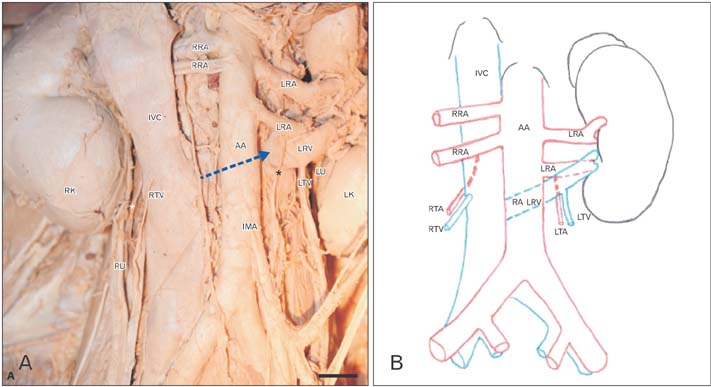Anat Cell Biol.
2018 Mar;51(1):62-65. 10.5115/acb.2018.51.1.62.
A rare combined variation of the coeliac trunk, renal and testicular vasculature
- Affiliations
-
- 1Department of Anatomy, School of Medicine, University of Namibia, Windhoek, Namibia. qwessels@unam.na
- 2Lancaster Medical School, Faculty of Health and Medicine, Lancaster University, Lancaster, UK.
- KMID: 2418396
- DOI: http://doi.org/10.5115/acb.2018.51.1.62
Abstract
- The authors report a rare variation of the coeliac trunk, renal and testicular vasculature in a 27-year-old male cadaver. In the present case, the coeliac trunk and superior mesenteric artery was replaced by a modified coeliacomesenteric trunk formed by hepato-gastric and superior mesenteric arteries. Here the hepato-gastric artery or trunk contributed towards the total hepatic inflow as well as a gastro-duodenal artery. A separate right gastric artery and an additional superior pancreatico-duodenal artery was also found in addition with a retro-aortic left renal vein and a bilateral double renal arterial supply. The aforementioned coeliac trunk variation, to our knowledge, has never been reported before and this variation combined with the renal vasculature requires careful surgical consideration.
Keyword
Figure
Reference
-
1. Haller VA. Icones anatomicae quibus praecipuae aliquae partes corporis humani delineatae proponuntur et arteriarum potissimum historia continetur. Gottingen: A Vandenhoeck;1756.2. Bay JC. Albrecht Von Haller Medical Encyclopedist. Bull Med Libr Assoc. 1960; 48:393–403.3. Mariani GA, Maroni L, Bianchi L, Broccoli A, Lazzarini E, Marchegiani G, Mazzotti A, Mazzotti MC, Billi AM, Piccari GG, Cocco L, Manzoli L. Hepato-gastric and spleno-mesenteric arterial trunks: anatomical variation report and review of literature. Ital J Anat Embryol. 2013; 118:217–222.4. Sumalatha S, Hosapatna M, Bhat KR, D'Souza AS, Kiruba L, Kotian SR. Multiple variations in the branches of the coeliac trunk. Anat Cell Biol. 2015; 48:147–150.
Article5. Fahmy D, Sadek H. A case of absent celiac trunk: case report and review of the literature. Egypt J Radiol Nucl Med. 2015; 46:1021–1024.
Article6. Lovisetto F, Finocchiaro De Lorenzi G, Stancampiano P, Corradini C, De Cesare F, Geraci O, Manzi M, Arceci F. Thrombosis of celiacomesenteric trunk: report of a case. World J Gastroenterol. 2012; 18:3917–3920.
Article7. Walker TG. Mesenteric vasculature and collateral pathways. Semin Intervent Radiol. 2009; 26:167–174.
Article8. Tandler J. Über die varietaten der arteria coeliaca und deren entwickelung. Anat Hefte. 1904; 25:475–500.9. Fiorello B, Corsetti R. Splenic artery originating from the superior mesenteric artery: an unusual but important anatomic variant. Ochsner J. 2015; 15:476–478.10. Hayashi M, Kume T, Nihira H. Abnormalities of renal venous system and unexplained renal hematuria. J Urol. 1980; 124:12–16.
Article11. Nam JK, Park SW, Lee SD, Chung MK. The clinical significance of a retroaortic left renal vein. Korean J Urol. 2010; 51:276–280.
Article12. Mathews R, Smith PA, Fishman EK, Marshall FF. Anomalies of the inferior vena cava and renal veins: embryologic and surgical considerations. Urology. 1999; 53:873–880.
Article13. Shah D, Qiu X, Shah A, Cao D. Posterior nutcracker syndrome with left renal vein duplication: An uncommon cause of hematuria. Int J Surg Case Rep. 2013; 4:1142–1144.
Article14. Cuéllar i, Quiroga Gómez S, Sebastià Cerqueda C, Boyé de la Presa R, Miranda A, Alvarez-Castells A. Nutcracker or left renal vein compression phenomenon: multidetector computed tomography findings and clinical significance. Eur Radiol. 2005; 15:1745–1751.
Article
- Full Text Links
- Actions
-
Cited
- CITED
-
- Close
- Share
- Similar articles
-
- Multiple variations in the branches of the coeliac trunk
- Unique variation of the left testicular artery passing through a vascular hiatus in renal vein
- MDCT Findings of Right Circumaortic Renal Vein with Ectopic Kidney
- Multiple Vascular Variations in Posterior Abdominal Region: A Case Report
- Abnormal ramification pattern of the renal and testicular vessels




